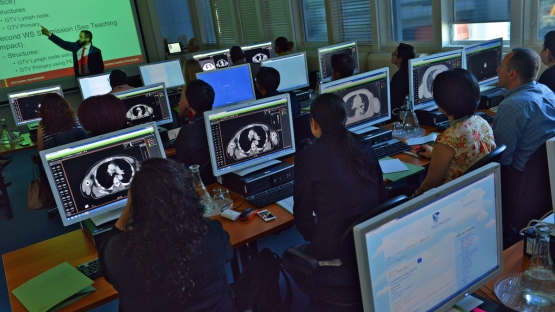Hands-on training with the latest cancer treatment tools helps radiation oncologists — specialized doctors — to deliver precise radiation treatment for managing cancerous or malignant tumours while minimizing harm to healthy tissue caused by unnecessary radiation exposure. This type of training is often out of reach for doctors in low and middle income countries. With the launch of a series of new IAEA workshops, radiation oncologists are getting training in 3-D radiation therapy planning.
“It is very important to be as accurate as possible when irradiating a tumour,” said Mark Mseti, radiation oncologist from Ocean Road Cancer Institute in Tanzania who participated in the pilot workshop at IAEA headquarters. “The concept of target volume definition and contouring is about making sure that the radiation we use is actually focusing on the disease and not on the healthy tissue. If you can obtain accuracy in drawing, or contouring, the tumour, you will have a higher probability of targeting and obtaining the goals of treatment, while sparing as much of the healthy, normal tissues as you can.”
Cancer is the uncontrolled division of abnormal cells in the body, and radiation can be used to stop that division of cells. Specific doses of radiation can damage cells beyond repair, causing them to stop dividing and to die. This makes radiation very useful for managing and treating cancer, but if the radiation is imprecisely or improperly targeted at the tumour, or delivered at the wrong dose level, the patient’s healthy cells can be unnecessarily damaged or eliminated, or the cancer cells are only partially eliminated, leaving other cancer cells to continue dividing in the person’s body. This could put the patient at risk of health complications in the short or long term.
Following requests from Member States, the IAEA brought together oncologists from 20 low and middle income countries earlier this month to receive training from experts on target volume definition and contouring for radiotherapy (see box). “Many of these doctors would otherwise be limited to primarily theoretical training due to economic and resource constraints hindering access to often costly hands-on courses,” said Eduardo Rosenblatt, Head of the Applied Radiation Biology and Radiotherapy Section at the IAEA.
We plan to start 3-D radiotherapy by early next year in my country, and this course is quite enriching in terms of knowledge and exposure, and helps us to meet IAEA standards.



